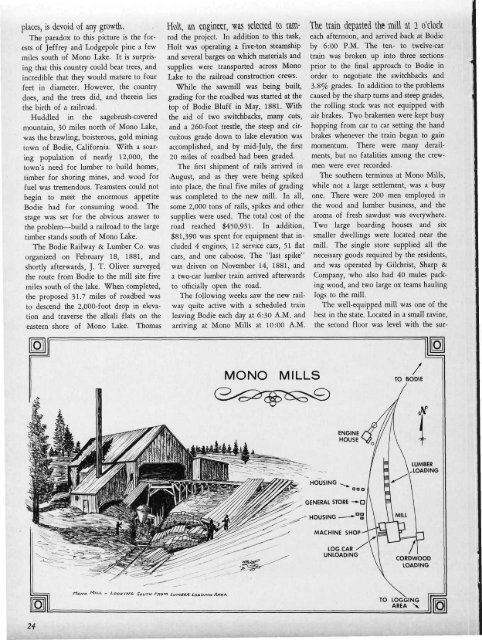DECEMBER, 1971 50c - Desert Magazine of the Southwest
DECEMBER, 1971 50c - Desert Magazine of the Southwest
DECEMBER, 1971 50c - Desert Magazine of the Southwest
Create successful ePaper yourself
Turn your PDF publications into a flip-book with our unique Google optimized e-Paper software.
places, is devoid <strong>of</strong> any growth,<br />
The paradox to this picture is <strong>the</strong> forests<br />
<strong>of</strong> Jeffrey and Lodgepole pine a few<br />
miles south <strong>of</strong> Mono Lake. It is surprising<br />
that this country could bear trees, and<br />
incredible that <strong>the</strong>y would mature to four<br />
feet in diameter. However, <strong>the</strong> country<br />
does, and <strong>the</strong> trees did, and <strong>the</strong>rein lies<br />
<strong>the</strong> birth <strong>of</strong> a railroad.<br />
Huddled in <strong>the</strong> sagebrush-covered<br />
mountain, 30 miles north <strong>of</strong> Mono Lake,<br />
was <strong>the</strong> brawling, boisterous, gold mining<br />
town <strong>of</strong> Bodie, California. With a soaring<br />
population <strong>of</strong> nearly 12,000, <strong>the</strong><br />
town's need for lumber to build homes,<br />
timber for shoring mines, and wood for<br />
fuel was tremendous. Teamsters could not<br />
begin to meet <strong>the</strong> enormous appetite<br />
Bodie had for consuming wood. The<br />
stage was set for <strong>the</strong> obvious answer to<br />
<strong>the</strong> problem—build a railroad to <strong>the</strong> large<br />
timber stands south <strong>of</strong> Mono Lake.<br />
The Bodie Railway & Lumber Co. was<br />
organized on February 18, 1881, and<br />
shortly afterwards, J. T. Oliver surveyed<br />
<strong>the</strong> route from Bodie to <strong>the</strong> mill site five<br />
miles south <strong>of</strong> <strong>the</strong> lake. When completed,<br />
<strong>the</strong> proposed 31.7 miles <strong>of</strong> roadbed was<br />
to descend <strong>the</strong> 2,000-foot drop in eleva-<br />
tion and traverse <strong>the</strong> alkali flats on <strong>the</strong><br />
eastern shore <strong>of</strong> Mono Lake. Thomas<br />
fiovo MILL. - LooKllVG- SOUTH f»M {.vmaex Lo&DiNa<br />
Holt, an engineer, was selected to ramrod<br />
<strong>the</strong> project. In addition to this task,<br />
Holt was operating a five-ton steamship<br />
and several barges on which materials and<br />
supplies were transported across Mono<br />
Lake to <strong>the</strong> railroad construction crews.<br />
While <strong>the</strong> sawmill was being built,<br />
grading for <strong>the</strong> roadbed was started at <strong>the</strong><br />
top <strong>of</strong> Bodie Bluff in May, 1881. With<br />
<strong>the</strong> aid <strong>of</strong> two switchbacks, many cuts,<br />
and a 260-foot trestle, <strong>the</strong> steep and circuitous<br />
grade down to lake elevation was<br />
accomplished, and by mid-July, <strong>the</strong> first<br />
20 miles <strong>of</strong> roadbed had been graded.<br />
The first shipment <strong>of</strong> rails arrived in<br />
August, and as <strong>the</strong>y were being spiked<br />
into place, <strong>the</strong> final five miles <strong>of</strong> grading<br />
was completed to <strong>the</strong> new mill. In all,<br />
some 2,000 tons <strong>of</strong> rails, spikes and o<strong>the</strong>r<br />
supplies were used. The total cost <strong>of</strong> <strong>the</strong><br />
road reached $450,931. In addition,<br />
$81,390 was spent for equipment that included<br />
4 engines, 12 service cars, 51 flat<br />
cars, and one caboose. The "last spike"<br />
was driven on November 14, 1881, and<br />
a two-car lumber train arrived afterwards<br />
to <strong>of</strong>ficially open <strong>the</strong> road.<br />
The following weeks saw <strong>the</strong> new rail-<br />
way quite active with a scheduled train<br />
leaving Bodie each day at 6:30 A.M. and<br />
arriving at Mono Mills at 10:00 A.M.<br />
MONO MILLS<br />
The train departed <strong>the</strong> mill at 1 o'clock<br />
each afternoon, and arrived back at Bodie<br />
by 6:00 P.M. The ten- to twelve-car<br />
train was broken up into three sections<br />
prior to <strong>the</strong> final approach to Bodie in<br />
order to negotiate <strong>the</strong> switchbacks and<br />
3.8% grades. In addition to <strong>the</strong> problems<br />
caused by <strong>the</strong> sharp turns and steep grades,<br />
<strong>the</strong> rolling stock "was not equipped with<br />
air brakes. Two brakemen were kept busy<br />
hopping from car to car setting <strong>the</strong> hand<br />
brakes whenever <strong>the</strong> train began to gain<br />
momentum. There were many derailments,<br />
but no fatalities among <strong>the</strong> crewmen<br />
were ever recorded.<br />
The sou<strong>the</strong>rn terminus at Mono Mills,<br />
while not a large settlement, was a busy<br />
one. There were 200 men employed in<br />
<strong>the</strong> wood and lumber business, and <strong>the</strong><br />
aroma <strong>of</strong> fresh sawdust was everywhere.<br />
Two large boarding houses and six<br />
smaller dwellings were located near <strong>the</strong><br />
mill. The single store supplied all <strong>the</strong><br />
necessary goods required by <strong>the</strong> residents,<br />
and was operated by Gilchrist, Sharp &<br />
Company, who also had 40 mules packing<br />
wood, and two large ox teams hauling<br />
logs to <strong>the</strong> mill.<br />
The well-equipped mill was one <strong>of</strong> <strong>the</strong><br />
best in <strong>the</strong> state. Located in a small ravine,<br />
<strong>the</strong> second floor was level with <strong>the</strong> sur-<br />
ENGINE<br />
HOUSE<br />
HOUSING -^<br />
GENERAL STORE -—Q<br />
HOUSING<br />
MACHINE SHOP<br />
LOG CAR<br />
UNLOADING<br />
TO LOGGING<br />
AREA

















